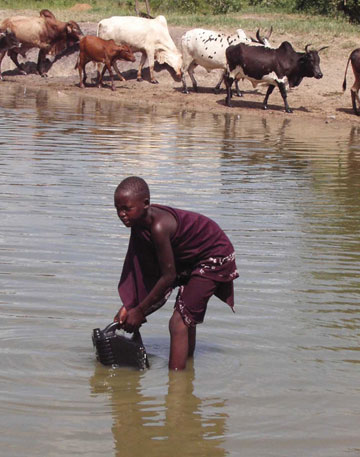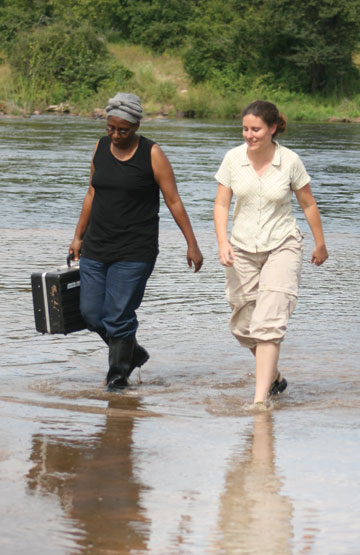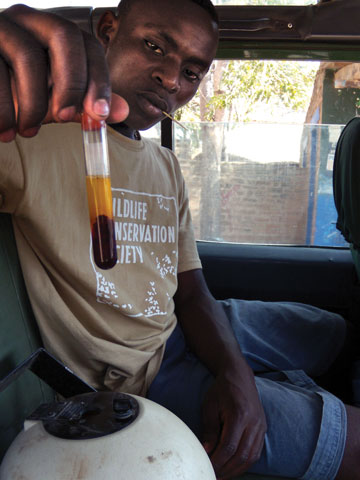Volume 26 · Number 2 · Winter 2009

(Photo: Joe Brownli/University of Edinburgh)
Troubled Waters in Tanzania
People, livestock, wildlife and infectious disease all come together at the dwindling water sources in rural Tanzania. UC Davis researchers are there, too, working alongside the Tanzanian people to improve their health and their environment.
Deana Clifford wakes up around six and looks for lion and elephant tracks outside her thatched hut known as a banda. Even huge animals can move almost silently at night, and she doesn’t want any surprises. After a cup of local Tanzanian coffee, Clifford calls her game scouts to see whether they have any new tissue samples from fresh kills. They do. She and her husband, Mike, pile sampling equipment into the Land Rover and head northwest on dirt roads, hoping they don’t snap a fan belt or get too many flat tires from the sharp acacia thorns that hide in the elephant dung on the road. Her epidemiological research — she studies the relationship of wildlife, livestock and human health in rural Tanzania — has required that she learn many new tricks. She knows now to always carry spare parts for the “Landy” in the glove compartment and how to shift deftly to get heavy vehicles through mud.
Clifford is working with her project’s lead researcher, Jonna Mazet, co-director of the School of Veterinary Medicine’s Wildlife Health Center, and Harrison Sadiki, a Tanzanian veterinarian and regional field coordinator (see article on page 27), to understand the risks of pathogens to people living in close contact with livestock under rough environmental conditions. They call their project HALI, which is both a Swahili word meaning “state of health” or “state of being” and an English acronym for Health for Animals and Livelihood Improvement. Underlining the mission of their project is the “one health” principle, which acknowledges the importance and interrelationship of health for people, health for animals and health for the environment.
A rapidly increasing human population, along with the industry, agriculture and commerce needed to sustain it, has dramatically expanded the intersection of rural and urban areas in Tanzania, accelerating the movement of pathogens and pollutants among people and animals. One such area is the land abutting Ruaha National Park. Here, floods in January 2007 brought the Great Ruaha River, along with a crocodile, into Clifford’s kitchen. But the seasonal floods belie the fact that the once-permanent water flow now dries up every year as more of the river is diverted to agriculture. This degrades the land, which weakens the ecosystem, which in turn makes it a breeding ground for disease.
Here the remaining pools of water are shared by livestock, wildlife and people, and as this valuable resource dwindles, the risk of people and animals becoming infected with disease-causing organisms and transmitting them to each other expands explosively.
The HALI team is working to better understand the causes and spread of these pathogens by conducting tests on livestock and wildlife and by sampling the water for organisms. They also closely examine the impacts of disease, not only directly on people’s health but on their livelihoods. The ultimate objective is to improve the health of the people and to collaboratively develop the means for their Tanzanian colleagues to continue the work. But they recognize the challenges confronting them.
“Recommending solutions from afar seems simple,” explains Woutrina Miller, a UC Davis microbiologist who sampled water for the project in Tanzania in spring 2008. “For example, keep the poop out of the water! But visiting the communities in Tanzania brought the reality to life. . . . It’s hot, we’re thirsty, let’s go to the nearest stream! Wouldn’t a swim or a drink be nice? Even if you go upstream from a known animal or human source, you are probably downstream from another source.”

Annette Kitambi, a HALI master’s student (left), and Deana
Clifford, HALI
project coordinator, take water samples. (Photo: Woutrina Miller)
Emerging infectious diseases have captured the attention of the public and the scientific community lately because of their potential worldwide impacts. Domestic animals and wildlife provide a reservoir from which they may emerge and re-emerge. The disease possibilities are frightening: Ebola, avian influenza, SARS and tuberculosis. All threaten human health, and are all zoonotic: They can be passed between humans and animals. And many of these emerging infectious diseases embark on their infectious journey in the tropics, in developing countries such as Tanzania.
The HALI Project is especially interested in tuberculosis, one of the most widespread infectious diseases and a leading cause of death for adults worldwide. In addition to being lethal on its own, TB also hastens the progression of HIV and AIDS, a disease that has hit central and southern Tanzania particularly hard. Although much attention has focused on treatment and prevention of human-to-human TB, TB from animal origins infects people and is an important and re-emerging public health concern in Tanzania and other developing countries.
With their Tanzanian colleagues, the HALI team is working to discover the level of disease transmission across species. The target diseases, including TB, can be transmitted to humans through unpasteurized milk, undercooked meat and contaminated water. The HALI team tests village water and livestock early in the morning before pastoralist families lead their cattle out to graze and again at night when they return. Wildlife are trickier to examine. Game scouts are valuable allies because they have access to freshly killed wildlife and are eager to share what they find.
One Tanzanian scout, Shukuru Mvena, never finished secondary school, but he is meticulous when examining tissue samples for TB. “Shukuru’s dedication to detailed work is a bonus for the project,” says Clifford. “You have to palpate the organ for abnormalities, then slice thinly, looking at the layers. He seems to know where the trouble spots might be and can see the smallest abnormalities. He’s a natural.” Mvena’s involvement illustrates HALI’s central focus: collaboration. Gone are the days when Western scientists and researchers arrived in an African country, got their results and left. Now, HALI researchers keep the village dynamic very much in mind while conducting the project because, if they fail to address the needs of the community, their eventual findings, while potentially important to other scientists, might never be used to help the people they hope to protect.
Another benefit of collaboration is the wisdom that the HALI team has received from their hosts. They must deal with extreme weather conditions, intermittent electrical power and frequent vehicle breakdowns in a region where acquiring spare parts can take weeks.
But the Tanzanians are experts at using whatever they have on hand and getting the most from their resources. Nothing gets wasted. Drivers have repaired broken fuel hoses and brake lines with spare plastic tubing and twine to get HALI teams home from the bush. When they do not have a needed piece of equipment, they can often find someone to fabricate something similar. The HALI team depends on the locals’ expertise in many ways. “When we started our study, we relied heavily on the advice of locals to find the water sites used by the communities,” Clifford recalls. “We could simply ask a secondary school student walking along the road where the water source was. By the end of the day, we might have five or six people in the car, and together they would show us where we should be sampling water.”
The Americans, in turn, provide what assistance they can to the community, emulating, as best they can, the resourcefulness of the Tanzanians. There is no doctor available in some of the areas where HALI works, “so whether it be the health of animals or people, we try to help,” says Clifford. “This can be as simple as giving a ‘lifti’ [a ride] to the hospital to someone who is ill or providing veterinary advice to the households we visit.” One day in the bush, the team got word that a game scout’s nephew had broken his arm. The closest hospital’s X-ray machine was not working, and the boy was sent back to his home village without a cast. The team of veterinarians took a look and used their first-aid equipment to place a temporary cast on the boy’s arm so that he would not injure it further. Being a part of the community brings understanding and cooperation that are critical to their rapid identification of solutions for the villages and resulting success of their project.
Harrison Sadiki
Veterinarians can often trace their dreams to become animal doctors to a single childhood moment. Harrison Sadiki, the Tanzanian regional field coordinator for the HALI project, is no exception. When he was 8, he watched a beloved family dog, Simba, die because of a bone caught in his back teeth.
To understand the disease threat and its impact, the HALI project uses surveys of pastoralists — the families who raise zebu, a short-horned cattle species, along with sheep and goats — to determine its effect on their livelihoods. The University of Vermont is a key collaborator on this portion of the project, but the surveys are all conducted by Tanzanian researchers. They want to know whether water scarcity increases the incidence of the disease in livestock and families, and how both disease and water scarcity affect the household economy. Survey questions to determine this include, among others: Are children going to school? Does anyone go without food or medicine? What are the economic impacts of disease? Of water limitations? How far is it to water? Tanzanian surveyors are used because Clifford recognizes that the responses would likely be very different if a Western researcher were present. So she gradually steps back, encouraging and assisting the professional and academic development of HALI project students and staff.
For Clifford, seeing Tanzanians become leaders has been one of the most rewarding parts of this work. Sadiki, the field coordinator, received a scholarship to travel to the U.S. in fall 2008 to present a paper at a conference; HALI’s Tanzania master’s student, Julius John, is now embarking on an academic career; and Howard Kombe, the HALI animal health technician, recently gave a presentation to international students and visitors from the Wildlife Conservation Society. Because HALI’s community-based approach provides training for Tanzanian researchers who can keep the project on track, because the pastoralist communities recognize the value of the program and because its findings, recommendations and interventions benefit local people, Clifford is confident that the project will succeed.

James Kibuga, HALI field assistant, tests blood samples for disease using a simple centrifuge that can be plugged into a car. (Photo: David Wolking/HALI)
To date, HALI researchers have discovered that bovine tuberculosis is present in wildlife inhabiting the area, as well as cattle that are housed in close contact with their pastoralist keepers. Human health hazards from TB and brucellosis via consumption of undercooked meat, exposure to contaminated tissues and consumption of unpasteurized milk are real. And they’re serious. The HALI team actively educates each household about the risks of contracting disease.
What’s next for HALI? The project is funded through June 2009. Team members hope to secure enough support to continue their research and activities, provide feedback to households and launch a pilot TB treatment program for pastoralist communities.
“Pathogens, toxins and environmental change are taking an increasing toll on the health of ecosystems,” says Mazet, the principal investigator. “The problems are complex, but they all point to this: We must develop the research, training capacity and service infrastructure to respond to these rapidly expanding problems, focusing not only on disease, but also on health at the individual, population and ecosystem levels.”
Always, there is more to be done and still so much to discover about the transmission of disease via interactions among people, animals and their rapidly changing environments. With this knowledge, the HALI team is hopeful that a scientific and culturally appropriate solution to disease problems will be possible.
The HALI project is funded by the U.S. Agency for International Development’s Global Livestock Collaborative Research Support Program, which is headquartered at UC Davis and supports many agricultural initiatives in developing countries. The Wildlife Health Center is a unit of the School of Veterinary Medicine and is unique in the academic ecosystem health arena because it approaches public and environmental health from an animal population perspective.
Click on these links for more information about HALI and for the HALI blog.
Alison Kent is publications coordinator for the Wildlife Health Center.
